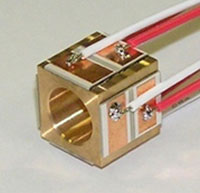Piezoelectric actuators: Why cubic?

An actual cubic actuator <br>Copyright : TUT<br><br>
Here, Tomoaki Mashimo and Shigeki Toyama analyzed the vibrational behavior of cubic stators based on an energy method, which distinguishes components of mechanical energy.
By changing the design of stators—especially the length in the direction of the through-hole axis—the researchers clarified how the vibrational modes are in accordance at one equal frequency in cubic shape.
The energy method described in this paper showed that the mechanical energy of two specific vibrational modes is in equilibrium. The shape for which the stator achieves equilibrium energy was found to be a cube.
This approach should be useful for not only studies on vibration, but also for design the stators with an easy-to-use modal analysis method.
Reference:
Tomoaki Mashimo and Shigeki Toyama.
Vibration Analysis of Cubic Rotary-Linear Piezoelectric Actuator.
IEEE Transactions on Ultrasonics, Ferroelectrics, and Frequency Control 58, 844–848, (2011).
Digital Object Identifier (DOI): 10.1109/TUFFC.2011.1877
Tomoaki Mashimo is now at the Electronics-Inspired Interdisciplinary Research Institute, Toyohashi University of Technology.
Department website: Electronics-Inspired Interdisciplinary Research Institute (EIIRIS) http://www.eiiris.tut.ac.jp/
Media Contact
All latest news from the category: Power and Electrical Engineering
This topic covers issues related to energy generation, conversion, transportation and consumption and how the industry is addressing the challenge of energy efficiency in general.
innovations-report provides in-depth and informative reports and articles on subjects ranging from wind energy, fuel cell technology, solar energy, geothermal energy, petroleum, gas, nuclear engineering, alternative energy and energy efficiency to fusion, hydrogen and superconductor technologies.
Newest articles

A universal framework for spatial biology
SpatialData is a freely accessible tool to unify and integrate data from different omics technologies accounting for spatial information, which can provide holistic insights into health and disease. Biological processes…

How complex biological processes arise
A $20 million grant from the U.S. National Science Foundation (NSF) will support the establishment and operation of the National Synthesis Center for Emergence in the Molecular and Cellular Sciences (NCEMS) at…

Airborne single-photon lidar system achieves high-resolution 3D imaging
Compact, low-power system opens doors for photon-efficient drone and satellite-based environmental monitoring and mapping. Researchers have developed a compact and lightweight single-photon airborne lidar system that can acquire high-resolution 3D…





















